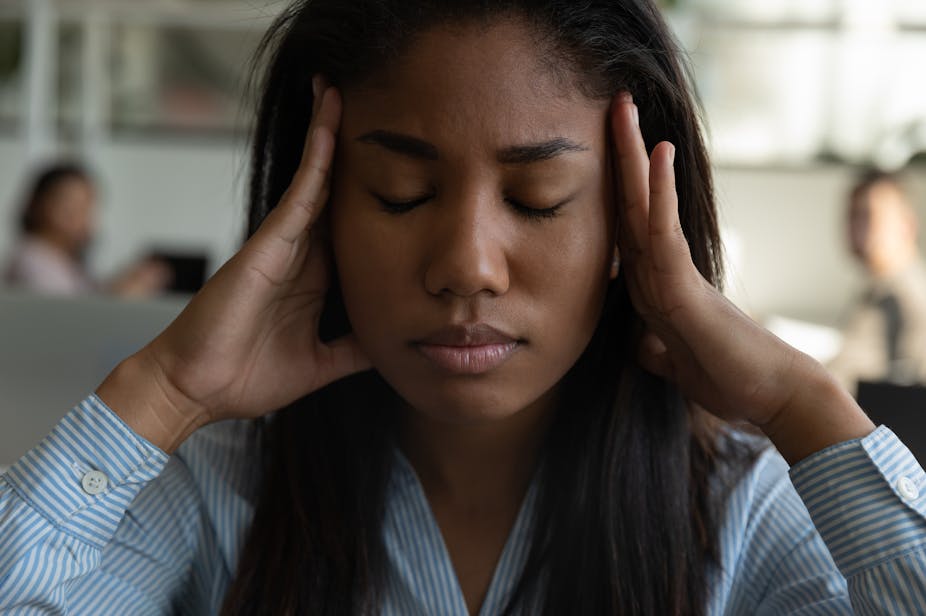Cluster headache may be one of the most painful conditions out there and it’s a neurological condition which affects around one in 1,000 people worldwide. The condition causes recurrent attacks of extreme pain on one side of the head, often around the eye region. Attacks last between 15 minutes to three hours, and may even happen multiple times a day. They may also tend to happen at night, and are more common in autumn and spring.
The cause of the disease is currently unknown, and there’s no cure. The only treatments available for managing cluster headache are designed to treat other health conditions, so their effectiveness is not optimal and treatment response may vary for each person.
Cluster headache has historically been considered a male disorder as it’s reported to be two to five times more common among men. But two recent studies we’ve published have revealed that while men may still be slightly more likely to suffer from cluster headache, women tend to be far more affected by the condition.
In our most recent study on cluster headache, we compared how the condition affected men and women. We recruited 575 men and 299 women in total, and asked them to fill out a questionnaire detailing their symptoms, what medications they took, their lifestyle habits and their headache triggers.
We discovered that women with cluster headache were more affected in their daily lives than men. They were also twice as likely to have the chronic, more severe form of cluster headache – affecting around 18% of female participants. Chronic cluster headache means they only have the equivalent of three months per year without symptoms. Women also reported having longer active headache periods (in some cases years of daily headaches) compared to men.
Women reported having more frequent nightly headache attacks – and stated that the lack of sleep appeared to be a trigger factor for attacks. We also noted that more female participants with cluster headache reported sleeping less than five hours per night compared to male participants.
Our study also found that women were more likely to use prescription drugs to manage their symptoms of cluster headache compared to men. Further, we found that almost 30% of women in the study had migraine in addition to cluster headache, compared to only around 13% of the male participants.
In another study we published recently, we used population registers to retrieve data on healthcare visits and absence from work or studies due to health issues. This allowed us to understand the true impact of cluster headache compared to the rest of the population. We looked at a total of 3,239 people with cluster headache and compared them to 16,200 people who didn’t have the condition.
Our research revealed that 94% of women who had cluster headache also suffered from other health conditions. In comparison, only around 89% of women without cluster headache suffered from other health conditions. But men with cluster headache were more likely to suffer from physical injuries than any other group. However, our study was not able to collect specific data on which kinds of health conditions or physical injuries these were.

We also found that patients with cluster headache who had several health conditions were more likely to miss work due to illness, or retire early because of disability. Women with cluster headache had twice as much sickness absence and retired earlier on average compared to both men with cluster headache and people who did not suffer from cluster headache.
Based on the results of both of our studies, it’s clear it’s time to stop thinking about cluster headache as a male disease and consider the disproportionate affect it has on women. It’s also important that the sex differences in how cluster headache manifests are well known so that GPs can provide the right care to all patients with cluster headache.
Although it’s clear from our research the impact cluster headache can have on a person’s life, it will be important for future research to use different study methods to ensure greater accuracy, and to look at whether men and women respond to treatments differently. It will also be important to investigate whether certain health conditions are more common in people with cluster headache compared to the rest of the population.
Many patients with cluster headache wait up to ten years to receive a proper diagnosis. This leaves them without access to any treatment or way of managing their condition. Given the serious affect cluster headache can have on all aspects of a person’s life and health as shown by our research, it’s important to continue raising awareness about the condition so that patients receive the help they need.

